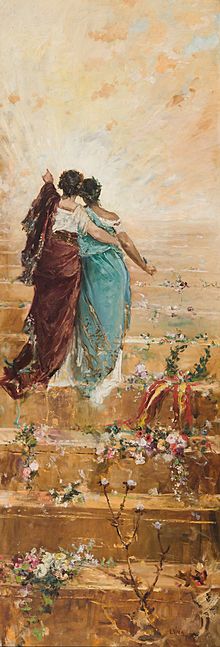España y Filipinas facts for kids
Quick facts for kids España y Filipinas |
|
|---|---|
| Spanish: España y Filipinas | |
 |
|
| Artist | Juan Luna |
| Year | 1884 |
| Medium | Oil on canvas |
| Dimensions | 229.5 cm × 79.5 cm (90.4 in × 31.3 in) |
| Location | National Gallery Singapore |
España y Filipinas (which means "Spain and the Philippines") is a famous series of oil paintings by the Filipino artist, Juan Luna. He was also a revolutionary activist. These paintings use allegorical figures, meaning they show ideas or qualities as people. They feature two women together. One woman represents Spain and the other represents the Philippines.
This painting is also known as España llevando a la gloria a Filipinas ("Spain Insuring the Glory of the Philippines") or España Guiando a Filipinas ("Spain Leading the Philippines"). Many people see it as one of the most important artworks that Filipinos have from Luna.
Contents
What the Painting Shows
The painting shows two women walking together. The taller woman represents Spain. She has "wide strong shoulders." The other woman represents the Philippines. She is shown as "graceful" and brown-skinned. Both women are wearing traditional Filipino dresses called traje de mestiza. This type of dress shows how Spanish culture influenced the Philippines in the 1800s.
Both women have their backs to the viewer. They are walking up the steps of a staircase towards a far-off horizon. In the painting, Spain appears to be leading the Philippines. She guides the Philippines along a path towards progress and development.
Spain, the taller white figure, is shown as a kind "Motherland." She points forward, guiding the "humbly dressed" Filipina. This image was meant to show a "benevolent" (kind) side of colonization. The painting was even featured in a book called El legado de España a Filipinas ("The Spanish Legacy in the Philippines"). The caption said: España guiando a Filipinas por la senda del progreso ("Spain leads the Philippines on their way to progress"). It was seen as a symbolic picture of the colonizer and the colonized walking together.
Why This Painting is Important
España y Filipinas is an oil on canvas masterpiece. It shows a close bond between Spain and the Philippines through the figures of two women. However, it is also a propaganda painting. This means it was created to spread a certain message. It showed the true hopes of Filipino activists, called Filipino propagandists, in the 1800s. They wanted the Philippines to become more like Spain. They hoped for reforms, equality, modernization, and better economic conditions.
Some people, like Jose Rizal, thought Luna was a "Hispanophile." This means they thought he would never go against Spain. But the España y Filipinas portrait shows a "less combative posture" from Luna. It was a way for him to show Spain and others what the Philippines needed at that time.
Different Versions of the Painting
Juan Luna reportedly painted six versions of España y Filipinas. The main ideas in each painting are very similar. Out of the six versions, only three have been found so far.
The First Painting (1884)
The earliest version was painted in 1884. You can see it today in the National Gallery Singapore. A Filipino politician named Pedro Paterno asked Luna to paint this version. Paterno was a good friend and supporter of Luna. This painting was later shown to the public in 1893 at an exhibition in Madrid, Spain.
For almost 130 years, this painting was owned by Don José Vázquez Castiñeira. He was a former mayor in Spain. It is thought that Pedro Paterno might have sold or given the painting to Vázquez Castiñeira. This happened when Paterno became the new Director of the Museo-Biblioteca de Filipinas. Interestingly, Paterno's wife was from the same region in Spain as Vázquez Castiñeira. In 1996, a descendant of José Vázquez Castiñeira decided to share her family's belongings. Among them were several artworks from the Philippines, including this 1884 painting.
Later, in 2012, the painting was sold at an auction in Barcelona. A private art dealer from the Philippines bought it. In 2013, this 1884 version of España y Filipinas was sold again at a Sotheby's auction in Hong Kong. It sold for a record price of HK$25.88 million (about US$2.693 million). This made it the most expensive Philippine artwork ever sold at an auction at that time.
The Second Painting (1888)
The second version is the largest in the series. Luna painted it in 1888. It is now part of the collection at the Museo del Prado in Madrid, Spain. It is currently on loan to the City Council of Cádiz. Víctor Balaguer i Cirera, who was a Spanish government minister, asked Luna to paint this one. He was very impressed by the first version Luna made for Pedro Paterno. Balaguer asked Luna to create an even more detailed painting. The goal of this large artwork was to encourage stronger connections between Spain and the Philippines. It was also used as a propaganda tool.
The Third Painting (1888-1893)
The third version of the painting is smaller than the second one. Luna created it between 1888 and 1893. This painting is now in the important collection of the López Museum and Library in Manila, Philippines. It was originally made for Víctor Balaguer after he retired. It was kept at the Biblioteca Museu Víctor Balaguer for some time. Later, a Filipino businessman named Eugenio López Sr. bought it for the López Museum and Library.
Images for kids
-
España llevando a la gloria a Filipinas 1888, Oil on canvas, 442 x 167 cm, Museo del Prado, on loan to the City Council of Cádiz.
See also
 In Spanish: España y Filipinas para niños
In Spanish: España y Filipinas para niños
- Spoliarium
- Las Damas Romanas
- The Death of Cleopatra
- The Blood Compact

